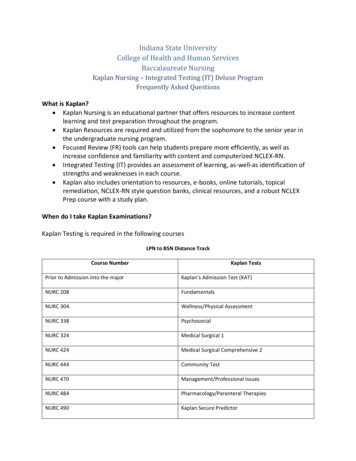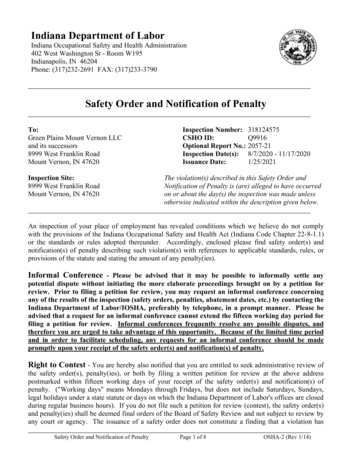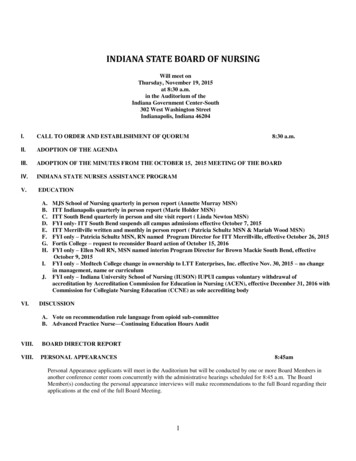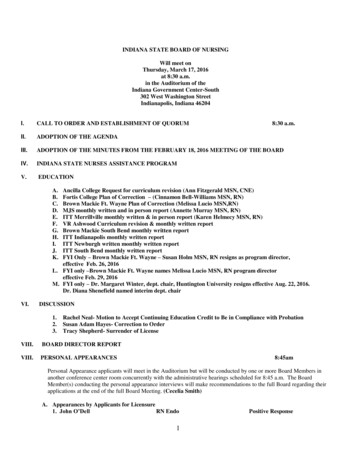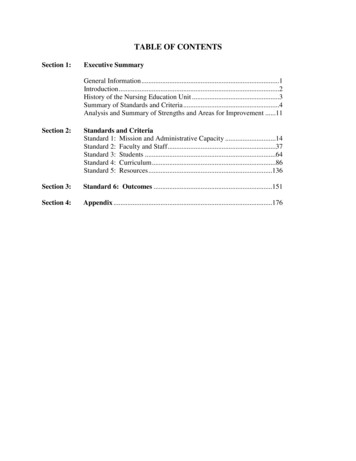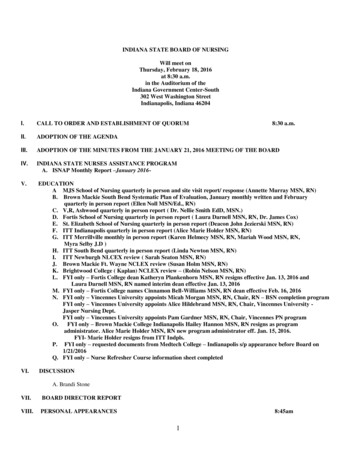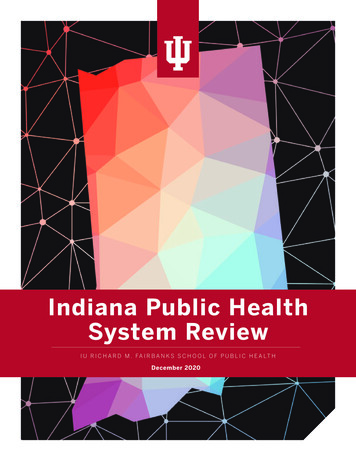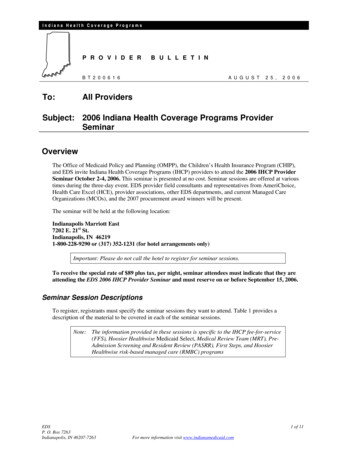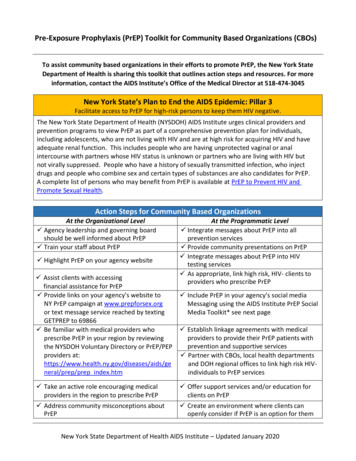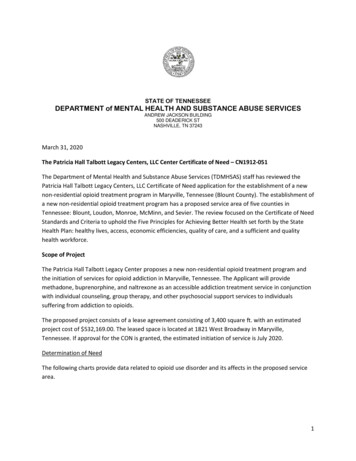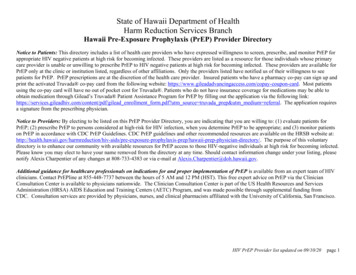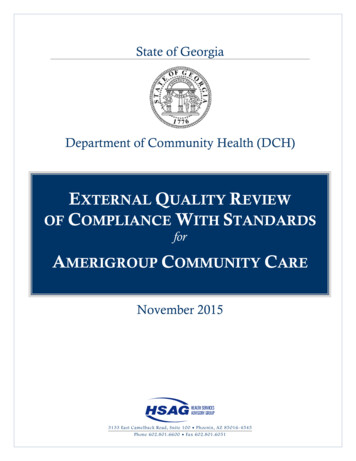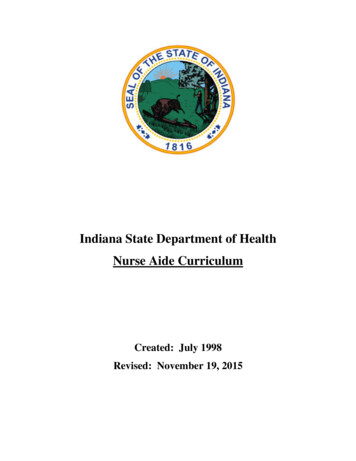
Transcription
Indiana State Department of HealthNurse Aide CurriculumCreated: July 1998Revised: November 19, 2015
Indiana Nurse Aide Training RequirementsThe Indiana Administrative Code (IAC 16.2-3.1-14CNA) requires a nurse aide working in ahealth facility to have successfully completed a nurse aide training program approved by theISDH. The ISDH also serves as the State Survey Agency for the Centers for Medicare andMedicaid Services (CMS) Health Care Facility Survey and Certification Program. Federalregulations at 42 CFR § 483 require the ISDH provide oversight for nurse aide training andcompetency programs. This Nurse Aide Curriculum was developed by the ISDH as the ISDHApproved Curriculum in compliance with state and federal regulations.In July 1998, the ISDH Division of Long Term Care created the Nurse Aide Curriculum. Thecurriculum was a product of the ISDH in conjunction with Professional Resources and inputfrom the Indiana Health Facilities Council Advisory Sub-committee. The curriculum was basedon the standards of practice for nurse aides at that time.The care provided today at Indiana nursing homes has a higher acuity level than in the past.Nurse aides play an increasing important role in the delivery of quality health care. In 2012 theISDH began a project to update the nurse aide curriculum to better reflect current standards ofcare. The curriculum was reviewed by the ISDH Division of Long Term Care, ISDH Division ofHealthcare Education and Training, academic institutions, nurse aide training programs, and longterm care provider associations. The updated nurse aide curriculum was completed and releasedin September 2013. Nurse aide training programs were to implement by January 1, 2014.The ISDH will further update the curriculum as changes or corrections are identified. Nurse aidetraining programs should check the ISDH Web site periodically for any changes to thecurriculum.
Indiana Nurse Aide CurriculumThe Indiana Nurse Aide Curriculum is organized into thirty (30) “lessons”. The curriculumestablishes the minimum standards for an approved program. Each lesson provides objectives,terms, content, and review questions. Each nurse aide training program is expected to includethis content as part of their course.The training entity shall utilize the lesson plans as a basis for training and may complement thelessons using a text of choice. It is the responsibility of the training entity to ensure that, if a textis utilized, any variance in the content of the text from the Indiana Nursing Assistant Scope ofPractice shall be identified to prevent misinformation as to the duties of the nursing assistant.The nurse aide lesson plans serve as a “guide” for classroom lecture. Resident care proceduresshould be introduced and demonstrated during lecture and then reinforced during the clinicalexperience.Should a standard of practice, at any time, be revised by an applicable regulatory entity, thetraining entity shall be responsible to update the lesson plan accordingly without waiting for anupdate and/or revised curriculum to be distributed by theIndiana State Department of Health.
TABLE OF CONTENTSPagesLesson 1- Introduction to the Role of the Nurse AideI. Introduction to Long Term CareII. The Role of the Nurse AideIII. The Care Team and the Chain of CommandIV. Communication and Interpersonal SkillsV. Resident-Centered Care (Person-Centered Care)1-9Lesson 2 – Resident RightsI. Origin/PurposeII. List of RightsIII. Protection of Resident RightsIV. Abuse, Neglect, and Personal Possessions/Misappropriation10-14Lesson 3 – Infection ControlI. Introduction to Infection ControlII. Hand HygieneIII. Personal Protective Equipment – PPEIV. Precautions15-20Lesson 4 – Infection Control, continuedI. Infectious Disease/Infectious ConditionII. Infection Control PracticesIII. Review of Personal Infection Control Practices21-25Lesson 5 – Medical Concerns/Emergency ProceduresI. AccidentsII. FallsIII. ChokingIV. Burns/ScaldsV. PoisoningVI. Medical EmergencyVII. Safety Measures/Prevention Strategies26-31Lesson 6 – Fire Safety and Other Resident Safety ConcernsI. Fire SafetyII. Side rails/EntrapmentIII. Resident ElopementIV. Smoking32-36Lesson 7 – Basic Nursing Skills (Vital Signs, Height and Weight)I. Initial StepsII. Final Steps37-40
PagesIII. Vital SignsIV. Measuring and Recording Height and WeightLesson 8 – Activities of Daily Living – (Positioning/Turning, Transfers)I. Proper Positioning and Body AlignmentII. Commonly Used PositionsIII. Proper Transfer41-47Lesson 9 – Activities of Daily Living – (Devices Used for Transfer)I. Using Mechanical LiftsII. Transfer Resident to Stretcher/Shower BedIII. Transfer – Two Person Lift48-50Lesson 10 – Activities of Daily Living – (Bathing, Shampoo, Perineal Care)I. Shower/Shampoo/Drape-Undrape/Bed Bath/Perineal Care/Back Rub/Catheter Care/Whirlpool51-53Lesson 11 – Activities of Daily Living – (Oral Care, Grooming, Nail Care)I. Grooming/Personal Hygiene54-57Lesson 12 – Activities of Daily Living – (Dressing, Toileting)I. DressingII. Toileting58-62Lesson 13 – Resident EnvironmentI. Unoccupied BedII. Occupied BedIII. Resident Room/Environment/Fall Prevention63-66Lesson 14 – Activities of Daily Living – Nutrition/Hydration67-75I. Promoting Proper Nutrition and HydrationII. Promoting the Use of Proper Feeding Technique/Assisting a Resident with Special NeedsIII. Caring for a Resident with a Tube Feeding and the Resident at Risk for AspirationLesson 15 – Skin Care/Pressure PreventionI. Understanding the Integumentary System and Basic Skin CareII. Risk Factors for Skin BreakdownIII. DevelopmentIV. PreventionLesson 16 – RestraintsI. Physical Restraint76-8283-86
PagesLesson 17 – Rehabilitation/Restorative ServicesII. RehabilitationIII. Restorative ServicesIV. Devices which May be Applied per Restorative Nursing Program87-90Lesson 18 – Oxygen UseI. Oxygen Use91-94Lesson 19 – Devices/Interventions – Prosthetics, Hearing Aids, Artificial,Eye, Eyeglasses, Dentures, and Compression StockingsI. Purpose of a Prosthetic DeviceII. Types of Prosthetic DevicesIII. Role of CNA regarding Amputations and Prosthetic CareIV. Role of CNA regarding Hearing AidsV. Role of CNA regarding Artificial Eye and EyeglassesVI. Role of CNA regarding DenturesVII. Role of CNA regarding Elastic/Compression Stockings95-98Lesson 20 – Special Care Needs Intravenous Fluids, Non-PharmacologicPain InterventionsV. Purpose of IV or PICCII. Role of CNA in caring for IV/PICCVI. Infection ControlIV. Pain FactorsVII. Role of CNA related to Pain99-102Lesson 21 – Cognitive Impairment/Dementia/Alzheimer’sI. ConditionsII. Behaviors, Causes and InterventionsIII. Methods/Therapies to Reduce BehaviorsIV. Tips to Remember when Dealing with Cognitively Impaired ResidentsV. Communication StrategiesVI. Techniques to Handle Difficult BehaviorsVII. Behavior Interventions103-113Lesson 22 – Mental Health, Depression and Social NeedsI. Causes of Mental IllnessII. Response to BehaviorsIII. Use of Defense MechanismsIV. Types of Mental IllnessV. Behaviors Associated with Mental Disorders – Actions and InterventionsVI. Treatment for Mental Illness114-120
VII. Special ConsiderationsVIII. Mental Illness and Intellectual Disability Mental RetardationLesson 23 – Common Diseases and Disorders – Nervous, Circulatory &Musculo-Skeletal SystemsNervous SystemI. Nervous SystemII. Conditions that Affect Nervous SystemIII. Normal Nervous System Changes with AgeIV. Role of the CNACirculatory SystemI. Circulatory SystemII. Conditions that Affect the Circulatory SystemIII. Normal Circulatory Changes with AgeIV. Role of the CNAMusculo-Skeletal SystemI. Musculo-Skeletal SystemII. Conditions that Affect the Musculo-Skeletal SystemIII. Importance of Exercise and Range of Motion (ROM)IV. Normal Musculo-Skeletal Changes with AgeV. Role of CNAPages:121-127Lesson 24 – Common Diseases and Disorders – Respiratory and UrinaryRespiratory SystemI. Respiratory SystemII. Common Conditions of the Respiratory SystemIII. Normal Changes with AgeIV. Role of CNAUrinary SystemI. Urinary SystemII. Common Conditions of the Urinary SystemIII. Normal Changes with AgeIV. Role of the CNA128-131Lesson 25 – Common Diseases and Disorders – Gastrointestinal, EndocrineGastrointestinal SystemsI. Gastrointestinal SystemII. Common Conditions of the Gastrointestinal SystemIII. Normal Changes with AgeIV. Role of the CNAEndocrine SystemI. Endocrine SystemII. Common Conditions that Affect the Endocrine SystemIII. Normal Changes with AgeIV. Role of the CNA132-135
PagesLesson 26 – Common Diseases and Disorders – Reproductive, Immune/Lymphatic SystemsI. Common Conditions of the Reproductive SystemII. Normal Changes with AgeIII. Role of the CNAIV. Common Conditions of the Immune and Lymphatic SystemsV. Normal Changes with AgeVI. Role of the CNA136-138Lesson 27 – Admission/Transfer/DischargeI. Admitting a New Resident to the FacilityII. Assisting to Transfer a Resident to a Hospital (i.e., Care Transition)III. Assisting a Resident to Discharge Home or to Another Facility139-141Lesson 28 – End of LifeI. Advance DirectivesII. Role of HospiceIII. Care of the Dying ResidentIV. Signs/Symptoms of Impending DeathV. Post Mortem CareVI. Disposition of Personal Belongings142-145Lesson 29 – Daily ResponsibilitiesI. Day to Day Time Management/Resident CareII. Interdisciplinary Care Plan Meetings146-148Lesson 30 – Protecting Your ProfessionI. Reducing Stress/BurnoutII. Abuse/Neglect/MisappropriationIII. Nurse Aide Testing/Certification149-153APPENDIX AResident Care Procedures1. Initial Steps2. Final Steps3. Hand washing/Hand rub*4. Gloves*5. Gown*6. Mask*7. Falling or Fainting*8. Choking*9. Seizures*154
10. Fire*11. Fire Extinguisher*12. Oral Temperature (Electronic)13. Axillary Temperature14. Pulse and Respiration15. Blood Pressure16. Height17. Weight18. Assist Resident to Move to Head of Bed19. Supine Position20. Lateral Position21. Fowler’s Position22. Semi-Fowler’s Position23. Sit on Edge of Bed24. Using a Gait Belt to Assist with Ambulation25. Transfer to Chair26. Transfer to Wheelchair27. Walking28. Assist with Walker29. Assist with Cane30. Transfer to Stretcher/Shower Bed*31. Transfer: Two Person Lift*32. Shower/Shampoo33. Bed Bath/Perineal Care34. Back Rub35. Bed Shampoo*36. Oral Care37. Oral Care for Unconscious38. Denture Care39. Electric Razor40. Safety Razor41. Comb/Brush Hair42. Fingernail Care43. Foot Care44. Change Gown45. Dressing a Dependent Resident46. Assist to Bathroom47. Bedside Commode*48. Bedpan/Fracture Pan49. Urinal50. Empty Urinary Drainage Bag*51. Urine Specimen Collection*52. Stool Specimen Collection*53. Application of Incontinent Brief54. Unoccupied Bed*55. Occupied Bed
56. Thickened Liquids*57. Passing Fresh Ice Water58. Feeding59. Assist to Eat60. Inspecting Skin61. Float Heels62. Bed Cradle*63. Passive Range of Motion64. Splint Application*65. Abdominal Binder*66. Abduction Pillow*67. Knee Immobilizer*68. Palm Cones69. Nasal Cannula Care70. Assisting with Hearing Aids71. Elastic/Compression Stocking Application72. Post Mortem Care** May be simulated in lab if clinical experience is not available*** Please note – bolded steps in the RCP’s indicate Critical StepsUpdated: January 15, 2014Lesson # 1
Title: Introduction to the Role of the Nurse AideLesson Objectives:I.The student will be able to describe Long Term Care in comparison with other healthcaresettings.II. The student will be able to describe the role of the Nursing Assistant, including the Scope ofPractice and the role of facility policies and procedures which may govern care and conduct.III. The student will be able to explain the members and roles of the Interdisciplinary CareTeam and the Chain of Command.IV. The student will be able to demonstrate the importance of both verbal and non verbalcommunication, barriers to effective communication, and interpersonal skills.V. The student will be able to explain culture change/resident centered care and the need toincorporate into daily care.Key Terms:Activity Director (AD) – an individual who plans the activities for the residents and assists themto socialize and to stay physically and mentally active.Activities of Daily Living (ADLs) – personal daily care tasks including, bathing, dressing,caring for teeth and hair, toileting, eating and drinking.Acute – a current illness that has severe symptoms and maybe as a result of a sudden onset.Administrator – manages all departments within the facility.Adult Day Care – care given at a facility during day time hours; generally for individuals whoneed some assistance and/or supervision but are not seriously ill or disabled; usually resideoutside of the facility.Advanced Practice Nurse - a registered nurse having education beyond the basic nursingeducation and certified by a nationally recognized professional organization in a nursingspecialty, or meeting other criteria established by a Board of Nursing.Assisted Living – facilities where residents live who need limited assistance, but do not requireskilled care.Call Light – means to communicate to staff a need for assistance. The call light should beavailable to the resident at all times.1 Page
Certified Nursing Assistant (CNA) – an individual who has completed a state approved courseand has successfully completed certification testing. A CNA provides direct care.Chain of Command – the line of authority in the facility which addresses to whom eachemployee/department reports.Chronic – the disease or condition is long term or will be long lasting.Clichés – phrases that are used frequently and which often have a different meaning, making itdifficult for the resident to understand.Communication – the process of exchanging information with others.Cultural Differences – beliefs, values, habits, diet and health practices that relate to a person’sculture or religion.Cultural Diversity – the variety of people living and working together in the facilityCulture – a system of behaviors people learn from the people by which they are surrounded.Culture Change – a philosophy that focuses on providing “person-centered” care to residentsand creating a positive work environment for healthcare workersDenial – rejection of a thought or feeling.Dependent – requires staff assistance to carry out activities of daily living.Dietitian – plans menus, special diets and monitors nutritional needs of the resident.Displacement – transferring a strong negative feeling to something or someone else.Health Insurance Portability and Accountability Act (HIPAA) – law that requires healthinformation to be kept secure (protected) and private.Home Health Care – care provided in a person’s home.Hospice Care – care for individuals who have an estimated six months or less to live; hospiceprovides physical and emotional care and comfort.Housekeeping Department – responsible to maintain the facility in a clean and sanitary mannerIndependent – able to carry out activities of daily living without staff assistanceInterdisciplinary Team – professionals from each discipline within the nursing facility whomeet to discuss and plan the care of the resident.Laundry Department – oversees laundering of facility linens and residents’ personal clothing.Licensed Practical Nurse (LPN) – a licensed professional who has completed 1 to 2 years ofeducation and has completed an exam for licensure.Long Term Care (LTC) – care for persons who require 24 hour care and assistance.2 Page
Maintenance Department – maintains facility and grounds in good repair.Medical Director – physician who provides oversight to the nursing staff regarding careprovided to the residents.Medical Doctor (MD) – physicianNon-Verbal Communication – communication without using words, such as facial expressions,tone of voice, posture, gestures, touch, body language, etc.Objective Information – information based on what is factually seen, heard, touched orsmelled. A direct observationOccupational Therapist (OT) – a therapist who helps residents to learn to compensate for theirdisabilities and assist them with activities of daily living.Ombudsman – resident advocate who investigates complaints and assists to achieve agreementbetween parties, often defending the rights of residents.Optometrist – provides eye care for the residents.Palliative Care – care that focuses on the comfort and dignity of the person rather than oncuring him or herPerson-Centered Care – a philosophical approach to nursing home care that honors andrespects the voice of elders and those working closest with them; it involves a continuing processof listening, trying new things, seeing how they work, and changing things in an effort toindividualize care and de-institutionalize the nursing home environment.Physical Therapist (PT) – provides therapy in the form of heat, cold, massage, ultrasound,electricity and exercise to residents with muscle, bone and joint problems. A PT may help aperson to safely use a walker, cane or wheelchair.Podiatrist – a physician who examines and cares for the residents’ feet.Policy – a course of action determined by the facility that should be taken every time a certainsituation occurs.Procedure – the steps to be taken to carry out a task; a particular way of doing something.Professionalism – how a person behaves when he/she is on the job. Examples of professionalinteractions with the resident include, but are not limited to:-Keeping a positive attitude doing the assigned tasks you are trained to perform-Keeping information about the resident confidential3 Page
-Being polite – not discussing your personal problems with a resident or with a co-workerin front of a resident.-Not using profanity, even if a resident uses profanity-Listening to the resident-Calling the resident by Mr., Mrs., Ms., or by the name he/she prefers-Always explaining the care you will be providing before beginning to provide the care-Presenting a positive image through personal hygiene, appearance and state of mindProjection – seeing feelings in others that are really one’s own.Qualified Medication Aide (QMA) – a certified nursing assistant who has completed requiredstate training and has completed examination in an effort to administer medications and certaintreatments in accordance with the specific scope of practice of the QMARationalization – making excuses to justify a situation.Registered Dietitian (RD) – a professional who creates special diets for residents with specificneeds and plans menus to ensure residents’ nutritional needs are met.Registered Nurse (RN) – a licensed professional who has completed 2 to 4 years of nursingeducation and has completed the examination for licensure.Regression – going back to an old immature behavior.Repression – blocking painful thoughts or feelings from the mind.Respiratory Therapist – provides breathing treatment(s) and special equipment for respiratoryconditions.Scope of Practice – the tasks for which a nurse aide is trained, thus, allowed to do.Nurse Aide duties include but are not limited to:- Feeding residents- Helping residents with toileting and elimination needs- Assisting residents to move safely around the facility- Keeping residents’ living areas neat and clean- Encouraging residents to eat and drink- Caring for supplies and equipment- Helping to bathe and dress residents- Making beds- Helping residents with oral care and other hygiene needs4 Page
Skilled Care – medically necessary care given by a nurse or therapistSlang- terms/words used that may be specific to a generation and not easily recognizable and/oreasily misinterpreted by the resident.Social Worker (SW) – an individual who helps residents with psycho-social needs and assists toarrange needed services.Speech Therapist (ST) or Speech Language Pathologist (SLP) – a therapist who helpsresidents with speech and swallowing problemsStandard 14 – “The nurse aide will perform only the tasks in the course standards and ResidentCare Procedures manual, unless trained appropriately by licensed sta
Nov 19, 2015 · Indiana Nurse Aide Training Requirements . The Indiana Administrative Code (IAC 16.2-3.1-14CNA) requires a nurse aide working in a health facility to have successfully completed a nurse aide training program approved by the ISDH. The ISDH also serves as
